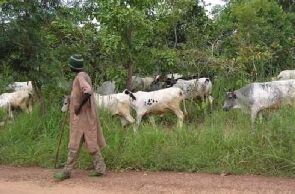It has emerged that the Asante Akyem North Municipal Assembly has incurred a debt of GH¢267 million since 2017 in keeping safety, peace and security within its jurisdiction which has been disturbed by a perennial violent conflict between nomadic herdsmen and indigenes.
Besides this debt, the municipal assembly still spends about two million Ghana Cedis a month translating into about 80 per cent of its share of the District Assembly Common Fund to ensure the peace remains undisturbed.
The Municipal Chief Executive, Mr. Francis Oti Bless, disclosed this at Akyawkrom near Ejisu in the Ashanti region at a workshop during which a team of scientists presented a preliminary findings of their research on the violent conflict between roving cattle herdsmen and farmers.
The ‘Access-Authority Nexus in Farmer-Herder Conflict’ project is a four and a half-year research into the actual causative factors of what has become a perennial farmer-herder conflict in parts of Ghana.
The research project, began in 2019 with an amount of two million Kroner by the Government of Denmark, is being undertaken by a team of scientists made up of Professors, post-doctoral, Ph.D. fellows and MPhil students from the Kwame Nkrumah University of Science and Technology (KNUST), University for Development Studies (UDS) and the University for Energy and Renewable Resources (UENR).
The study, which is tracing the history of the situation, has different teams looking at the herder-farmer conflict from different perspectives including the causes, impact on livelihoods, food security as well as peace and security of the affected geographical areas.
Using PowerPoint presentation, the team of scientists noted that, even with just a year more to complete the entire research project, has already made some important preliminary findings about the real issues at play in the conflict which they observe is not limited to only one administrative enclave in the country.
For example, it has tentatively unraveled irregular land allocation and occupation by both farmers and the nomadic herdsmen as the major underlying factor that is still leading to the loss of the lives of both humans and cattle, loss of livelihoods, poverty, insecurity and a substantial drain of the revenue of the concerned District Assemblies affected, leading to stagnation of socio-economic development in their respective jurisdictions.
The forum at Akyawkrom near Ejisu in the Ashanti was not only to enable the scientists present their initial findings to the key stakeholders in the subject matter but to also generate their inputs into the project, having held an inception forum with them before it took off in 2019.
Among the participants were officials from the Sekyere Afram Plains District and Asante Akyem North Municipality, traditional leaders, farmers, herdsmen and security personnel from the two districts where the study has concentrated as well as representatives of the Fulani community at the national level in addition to a delegation from the National Ranching and Transhumance Committee.
The Asante Akyem North Municipal Chief Executive, Mr. Francis Oti Bless, said the violent conflict between the roving cattle herders and the local people has existed for more than two decades and blamed the start of it on the ever-growing population of the nomads and their herds who were initially legitimately welcomed by the traditional authority in the area.
According to him, these visitors, with time, overstayed their welcome when they and their animals encroached farms of the local people while killing and maiming others. The MCE disclosed that, so far, the Assembly has incurred a debt of 267 million Ghana Cedis and still spending about two million Ghana Cedis on peacekeeping operations in the municipality every month.
The MCE “appealed to the government to absorb the debt as part of the national security expenditure because the cost of maintaining the peace and security in the area consumes about 80% of the Assembly’s share of the Common Fund. We are unable to undertake our planned development projects in the district. As I talk to you now, the Police is on the ground trying to guard our boundaries to prevent the cattle from coming in to destroy our farms, especially during this harmattan season.”
Mr. Oti Bless disclosed again, that so far, 69 people have been killed, 28 women raped, many people maimed, countless crop farms destroyed with many cattle also killed since the local community-herder relationship degenerated into violent conflict.
The Chairman of the National Ranching and Transhumance Committee, Dr. Kwame Oppong Anane, told Ashanti Today that, as part of government’s long-term measures to address the problem, the National Ranching and Transhumance Committee has established two community Ranches in the Afram Plains North and South districts in the Eastern Region with a combined holding capacity of 10 thousand cattle at a time and already receiving patronage by nomadic herdsmen. He disclosed other sustainable measures his Committee is taking towards achieving the goal of peaceful co-existence.
“We have also developed proposals to set up grazing reserves, 10 of them, and corridor systems across the country so that the cattle that come in annually from the sub-Saharian areas will have a place to go to for the periods that they are in the country so that they wouldn’t destroy any crops”, he assured.
Coordinator of the ‘Access-Authority Nexus in Farmer-Herder Conflict’ research project, Professor Kyereh Boateng, in an interview, disclosed that, even before the project ends, it has made a major breakthrough toward finding a permanent solution to the perennial conflict.
According to him, “when we started, people were not even prepared to talk to the researchers, some were afraid, some were saying whatever that they will say nothing will happen. People had lost trust and confidence in the system. But, through the dialogue, you see the number of people who have come here. People have now changed their attitudes. At the beginning, some people felt there is no way farmers and herders could come together. The two livelihoods are incompatible but now that is changing.”
Regional News of Saturday, 24 December 2022
Source: gbcghanaonline.com

















